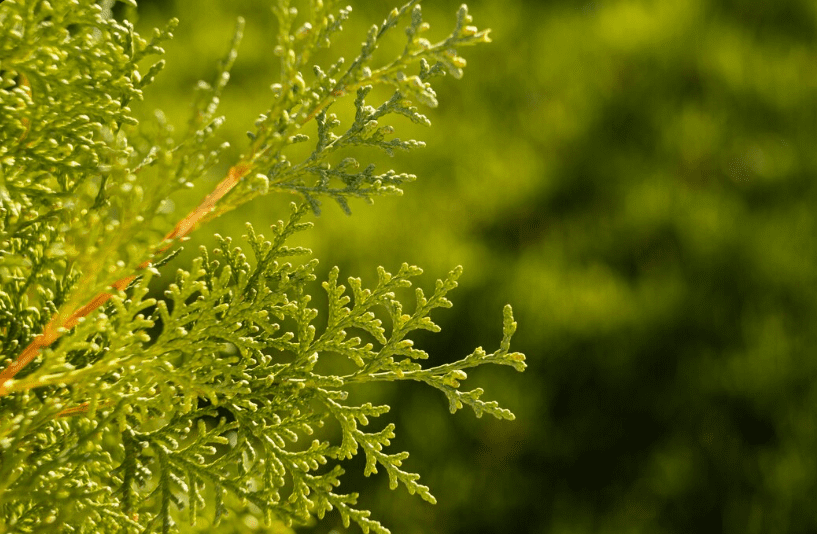
Thuja occidentalis
Latin name: Thuja occidentalis
Short name: Thuj
Common name: Arbor Vitae | White Cedar | Tree of Life | Northern White Cedar | American Thuja
Primary miasm: Sycotic Secondary miasm(s): Psoric
Kingdom: Plants
Family: Cupresseceae
- Symptomatology
- Remedy Information
- Differentiation & Application
Prepared from the fresh green twigs and leaves of the Thuja occidentalis tree, a member of the Cupressaceae family, native to North America. The essential oil contains thujone, a neurotoxin in large doses.
Traditionally used in herbal medicine for warts, respiratory ailments, and as an astringent. Also utilised ornamentally and as an antiseptic.
Proved by Samuel Hahnemann; published in Materia Medica Pura and Chronic Diseases
- Mucous membranes – especially genitourinary and respiratory
- Skin – warts, condylomata, oily eruptions, moles
- Genitals – sycotic lesions, gonorrhoeal after-effects
- Nerves – neuralgia, hypersensitivity, trembling
- Mind – fixed ideas, depression, duality of self
- Anus and rectum – polyps, fissures, tenesmus
- Urinary tract – frequent urging, cutting pain, split stream
- Left ovarian region – indurations, pain extending to groin and thigh
- Lymphatics – chronic swelling, suppression-related disorders
- Hair follicles – hair falling in spots, growths at root
- Warmth and wrapping up
- Profuse urination
- Drawing up limbs
- Gentle motion
- Pressure (in some pains)
- Warm, dry weather
- Damp weather, cold and wet air
- Vaccination
- Suppression of discharges (especially gonorrhoea)
- After midnight, especially 3–4 a.m.
- Coffee, onions, tea
- Touch, especially affected parts
- Moonlight, barometric changes
- Sitting or standing still
- Medorrhinum – Sycotic, restless, but more extreme, intense, and erratic
- Nitric acid – Warts and ulceration with splinter-like pains, more irritable
- Causticum – Warts, neuralgia, but more morally driven, sympathetic
- Silicea – Suppurations, but more chilly, yielding, and focused on expulsion
- Sepia – Induration and uterine issues, but more indifferent and collapsed emotionally
- Complementary: Natrum sulph., Silicea, Pulsatilla
- Antidotes: Pulsatilla, Camphora
- Follows well: Natrum mur., Sulphur
- Precedes well: Silicea, Nitric acid
- Inimical: Mercurius (conflicting actions)
Thuja reflects the shadow of suppressed self-expression. Its core is the split between outer composure and inner corrosion. The sycotic miasm brings overgrowth, secrecy, shame, and dissimulation. The patient may appear polished or reserved but wrestles internally with feelings of uncleanliness, fragmentation, and invasion—whether through vaccination, infection, or moral guilt. It is a remedy of duality: the seen vs. the hidden, the body vs. the perceived foreign presence. Ideal for aftereffects of vaccination, gonorrhoea, or suppressed skin ailments.
- Classic remedy for warts, condylomata, and sycotic miasm
- Indicated for post-vaccination effects, including behavioural change
- Useful in chronic urinary or genital tract conditions
- Consider for chronic fatigue, neuralgia, or mental disturbances after suppression
- Best suited to closed, reserved, secretive individuals with history of sexual trauma or moral guilt
- High potencies act deeply on mind and glands; low potencies useful for skin and mucous issues
Mind
- Delusion, body is brittle/glass
- Fixed ideas, as if possessed
- Secretive, closed
- Guilt, shame, feeling unclean
Skin
- Warts, multiple, moist, cauliflower
- Moles, growths
- Oily skin
- Suppressed eruptions
Urinary
- Urination, split stream
- Urethral pain after coition
- Frequent urging, night
Genitals
- Gonorrhoea, chronic
- Condylomata
- Left ovarian pain
Generalities
- Vaccination effects
- Left-sided complaints
- < damp weather, cold
- Tumour tendency
- Samuel Hahnemann – Materia Medica Pura / Chronic Diseases: Original proving and miasmatic classification
- James Tyler Kent – Lectures on Homoeopathic Materia Medica: Key mental and sycotic insights
- William Boericke – Pocket Manual: Valuable for modalities and clinical use
- John Henry Clarke – Dictionary of Practical Materia Medica: Expanded indications, skin and urinary focus
- C. Hering – Guiding Symptoms: Confirmatory observations on mental, skin, and gonorrhoeal pathology
